The Faroe Islands
In choosing his annual destinations for one-on-one trips with me, my 11-year-old son has always gravitated towards islands. See my posts on Easter Island, Palawan, the Maldives, Seychelles and Greenland! So it wasn’t a surprise when he selected the Faroe Islands this year.
Planning our Faroe Islands Itinerary
I started planning our Faroe Islands trip in mid-January for mid-July. I sketched out a week-long stay at three different destinations and started booking, only to find that it was extremely difficult to find availability. Through a lot of trial and error, and moving our trip dates back two weeks, I was finally able to piece together a schedule – three nights in Tórshavn, two nights in Gjógv, and two in Vágar. I then booked a rental car (it would be difficult exploring the islands without one), and finally felt comfortable booking our flights.
Getting to the Faroe Islands
The Faroe Islands are located above Scotland, roughly halfway between Iceland and Norway. They’re a country in that they’re self-governing, but technically they’re still a territory of Denmark. There are flights from a few places in the winter – notably Copenhagen and Billund (because Denmark) – and a lot more in the summer. As it was summer we had our choice of a dozen departure points and went for Reykjavik, Iceland. Reykjavik isn’t the easiest place to lay over for a day, given that it takes over an hour to get to town from the airport, and it’s expensive, but it’s the easiest/fastest way to get to the islands from the US. We stayed at Canopy by Hilton Reykjavik, right in the middle of the city.
Atlantic Airways has a virtual monopoly on flights in and out of the islands. Their service in Reykjavik was lacking. Our Airbus 320 flight was full, 160 passengers or so, and they only had one desk agent checking people in. The line was long! Compare that to United, which also had just one flight, but they had four agents. We arrived at Reykjavik Keflavik airport at 8:15am for our 10:10 flight, got in line, and finally made it to the desk an hour and a half later, at 9:45am – five minutes past our scheduled boarding time. But there were still a lot of people behind us, so even though the flight was showing on-time, we weren’t nervous. And sure enough, we ended up leaving roughly an hour late.
Once we arrived in the Faroe Islands (there’s only one airport, in Vágar), we got our luggage, went to the car rental counter, waited maybe five minutes for someone to show up, got our keys and were on our way.
Driving in the Faroe Islands
Driving is the Faroe Islands is fairly easy. There aren’t many roads. You’ll get confused trying to find hiking trails, since most are unmarked and Google Maps doesn’t work perfectly, but after a few u-turns you’ll figure it out. A few things to keep in mind:
- Our car had a manual transmission, and it looks like most of the other rentals did as well. Another reason to know how to drive a stick shift.
- You have to keep your lights on at all times.
- There are a lot of one-lane, two-direction roads. If you’re approaching another car, pull into the nearest pullout on your side of the road. If you’re heading uphill and another car is coming towards you, you need to back down until there’s a pullout. This happened to us twice.
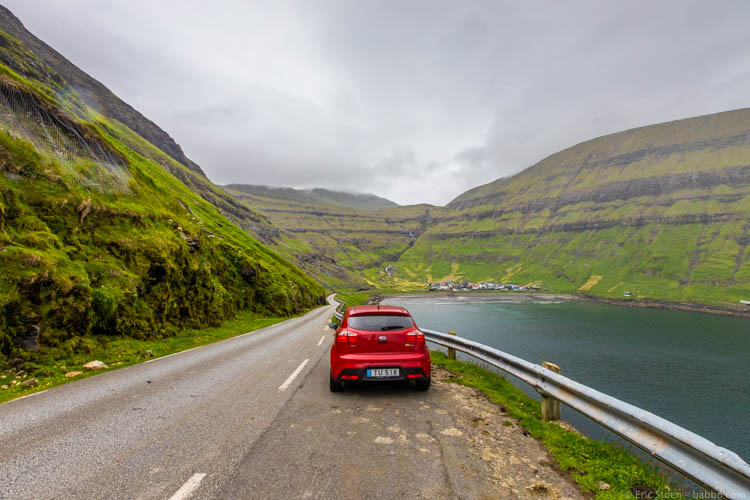
- There are also a few one-lane, two-direction tunnels. These are a little more nerve-wracking. One direction has the right-of-way and one is required to pull over. Between Torshavn and Vidoy, you have the right-of-way in both narrow tunnels going to Vidoy. There are pullouts roughly every 100 meters, so when you see headlights coming and you’re traveling in the non-priority direction, simply pull into the closest one. The exception is for trucks and large vehicles. They always get the right-of-way. But there are also warning signs outside the tunnels that will tell you not to enter, so it’s not as bad as it sounds.
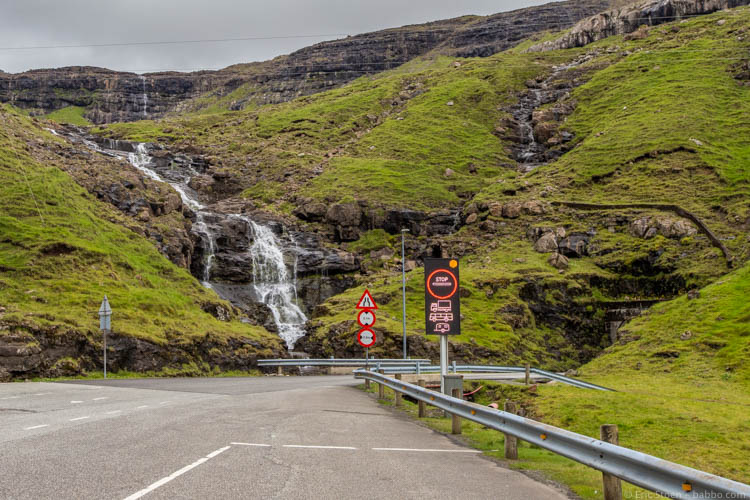
- Watch out for sheep. At least a few will cross the road in front of you. They’re not quite as dumb as squirrels, but they don’t pay much attention to approaching cars.
- There are enough gas stations to keep you from getting nervous. Don’t even try to use a US credit card at the pumps. Just fill up and then go inside to pay. We drove all over the islands over a week and stopped for gas twice.
- Pay attention to the timed parking signs (primarily in Torshavn), and set the little clock on your windshield for your arrival time. We saw at least one car with a ticket.
- We declined all auto insurance coverage as I assumed our credit card covered it. You can make your own choice regarding insurance. We have a family travel insurance policy in place that includes rental car damage.
- Generally 100km a day are included in the rental rate. We drove 513km over 7 days, so we weren’t close to going over.
Our Faroe Islands Itinerary
This was my son’s trip. I didn’t intend on taking a lot of photos or even doing a blog post, but: 1) it’s too gorgeous not to take pictures; and 2) several friends and people on social media said that they had been looking at traveling to the islands and wanted advice. So this is what we did!
Day One
With our delay from Reykjavik and the drive from Vagar to Torshavn, we didn’t arrive at our hotel until 3pm or so. We were still jet-lagged from the states and very hungry, so we checked in and immediately drove into Torshavn to have an early 4pm dinner. My son had posted on Reddit before our trip asking about Faroe Islands restaurants and one of the suggestions was Etika. After too much food (the sushi and meat sticks were very good) we walked around Torshavn for a while, headed up to the lighthouse, drove back to our hotel and went to sleep early.
Hotel: Hotel Føroyar, Torshavn. Decidedly mediocre.
Day Two
Torshavn is on the largest island in the Faroes, Streymoy. So we figured it made the most sense to explore Streymoy. We had breakfast at our hotel and drove all the way north to Tjørnuvik, roughly an hour away with a couple of waterfall stops. A friend had recommended the waffles and coffee in the middle of the village, and we had no trouble parking and then finding the waffle man. We encountered two other tourists already there, and then two showed up as we were leaving. Fairly quiet!
From Tjørnuvik we drove to Saksun, parked (we took the first left as we entered the village and found parking, but there’s a larger lot if you keep driving), and then walked down to Lake Pollurin. Note that a lot of people hike between Saksun and Tjørnuvik and back. We simply walked part way around the lake.
We drove back to Torshavn for a late lunch (pizza and gyros at Eta), and then it was time for soccer. There are small soccer/football fields throughout the Faroe Islands. Every small town seems to have one. Torshavn has the national stadium and two training fields next to the stadium, and several neighborhood fields. As the main training fields are reserved 4-9pm every day, we went to a small field a few minutes from our hotel and played for an hour. Then after some downtime, we headed back into Torshavn for dinner at The Tarv. Excellent lamb and salmon.
Hotel: Hotel Føroyar, Torshavn
Day Three
With a few long days of driving planned, we decided to relax and explore Torshavn on day three. It’s a small town so really it doesn’t take more than an hour to see most of the sites, but we had fun walking around. Lunch was at Fish & Chips, which we didn’t love, so we had a second lunch back at Eta. In the afternoon we drove to the national stadium and played football for hour. Dinner was at Toscana – very good, but annoying that they have a 6% surcharge for non-Danish credit cards. We didn’t see that anywhere else. A good reason to always have some cash with you.
Hotel: Hotel Føroyar, Torshavn
Day Four
This was a driving and hiking day. We headed out early and drove several islands away to Viðoy, the easternmost island that you can reach without a ferry, and the town of Viðareiði, the northernmost settlement in the Faroe Islands. It’s the farthest you can drive from Torshavn, and it still only took us an hour and a half.
We had seen the Viðareiði hike highly recommended by other travel writers. After a few wrong turns (thanks Google Maps), we found the trailhead. The correct directions: drive through town, take a right just before the small football/soccer field, drive to the end of the road and park. We enjoyed the hike. The first part of the hike is mainly a grass/mud path, and then it gets rocky and more difficult – especially for kids. We walked up to just beyond where the serious rocks started. It was high enough to get a great view.
From Viðareiði we drove back a few islands to Eysturoy and the town of Gjógv. We didn’t know anything about Gjógv – we were there simply because there are only so many places to stay in the Faroe Islands, and I was able to book a room for two nights. We checked into our hotel at 2pm, looked out from our room, saw people hiking along an upper ridge line, and thought it looked like a fun hike. So we filled our water bottles and started walking.
This turned out to be our second favorite hike of the trip. I don’t know if the hike even has a name, but it’s easy to figure out from town – just walk up to the northeast and you’ll find a gate with a payment box. There’s some controversy in the Faroe Islands whether farmers should be charging hikers for access to their land. I’m guessing a lot of people don’t pay, but we did. 50 DKK (US$7.50). We hiked up the steep coastal path/stairs to the top – there’s a sign at the end – and then walked back to our guesthouse through the sheep fields.
We had dinner at the guesthouse – really the only option in town. Excellent fish, ok potatoes and vegetables.
Hotel: Gjaargardur Guesthouse Gjógv. We loved it.
Day Five
We had intended to head to Kalsoy Island our fifth day. Kalsoy is famous for its Kallur lighthouse hike, and the photos are beautiful. However, you need to take a car ferry over, and there are only three departures from Klaksvík every morning (6:40, 8:00 and 10:00). Then the return ferries start at 2:50pm, with departures at 4:10pm, 5:15pm and 6:30pm as well. My son and I were sketching out the day and figured that since the ferries fill up fast in the summer (each only holds 16-17 cars), we would want to get there at least two hours in advance to hope for a spot. And it would be an hour drive between Gjógv and Klaksvík. Best case scenario we leave Gjógv at 5am hoping for the 8am ferry (possibly getting onto the 6:40am ferry), and then come back at 2:50, getting back to Gjógv by 4pm. That’s 11 hours round-trip for a hike and some photos – totally not worth it to us, especially since we loved Gjógv.
So instead we slept in, had breakfast at the guesthouse, walked around Gjógv, and then hiked to Hvíthamar. The hike starts roughly 3.5km from Gjógv, on the left of the road right before the road starts going downhill into a few hairpin turns. There’s no sign – just park and walk up the fence line. It was only roughly 20 minutes up and 10 minutes down and was stunning – especially as clouds constantly hid and revealed Funningsfjørður.
After the Hvíthamar hike we returned to the guesthouse, had lunch, relaxed and then hiked back up the mountain near the guesthouse, since we enjoyed it so much the day before. We finished with some soccer at the local field less than a minute from the guesthouse.
Hotel: Gjaargardur Guesthouse Gjógv
Day Six
After breakfast we checked out and hit the road to Gásadalur and the Múlafossur Waterfall. Even stopping several times along the way to enjoy the scenery, the drive only took an hour and a half. We took a few photos of the waterfall and then backtracked 15 minutes to the Hotel Vágar.
We had booked our final two nights at the hotel before we discovered Go Local Faroe Islands and their Mykines Evening Tour, where you travel out to Mykines on the 4:20pm ferry and then return at 11:00 the next morning. Given that there’s always the potential for bad weather and ferry cancellations we kept our Hotel Vágar reservation for our first night just to be safe. We checked in, had lunch, and repacked, leaving most of our luggage in the room.
At roughly 3:45 we drove to Port Sørvágur, arriving and easily finding parking just minutes later. The 4:20 ferry left right on time and at 5pm we pulled into the island of Mykines.
Mykines is amazing. It’s a small island with a very small main town. 15 people live there year-round, roughly 40-50 people live there in the summer, and 200-300 tourists visit every day to hike to the lighthouse and see puffins. After 5pm, though, only the local residents are left, along with 2-4 guests at a small lodge run by Oda.
Oda picked us up from the ferry and, along with a Brazilian couple, we walked to her lodge. We started with coffee and snacks, walked around the village for a little while, and then had dinner. The Indonesian fish curry soup was excellent – our best meal in the islands. Then at roughly 8:30pm we left for our sunset puffin hike.
The hike was easily our favorite thing we did in the Faroe Islands. The evening was beautiful, and it was just the five of us with maybe 50 sheep and tens of thousands of puffins. Oda took us to her favorite spots, keeping us safe on the edge of crazy cliffs, helping us through the mud, and teaching us all about puffins. She even had hot chocolate for us right at sunset. Magical doesn’t begin to describe it. And photos can’t capture it. If you do only one thing in the Faroe Islands, make it the Mykines Evening Tour.
Hotel: The Go Local Faroe Islands B&B
Day Seven
We woke up, had breakfast with Oda and the Brazilians, and walked around town and the coast for an hour. If there was availability on the 5pm ferry we would have loved to spend the day on Mykines, hike to the lighthouse and see more puffins. But the ferry sells out far in advance, so we traveled back to Vágar on the 11am ferry.
We had a few choices for the rest of the day. It just happened to be the Faroe Islands’ National Day – the largest celebration of the year. We could have driven 45 minutes to Torshavn and witnessed the festivities. But we had seen photos of very crowded National Day scenes, and that’s generally not kid-friendly. So we opted out.
Then there’s the hike around Lake Sørvágsvatn – the famous lake that comes almost to the edge of an 80-foot drop to the ocean. The trailhead was only a few minutes from our hotel so it would have been very easy to do. But we didn’t come to the Faroe Islands to get the same photos as everyone else, so we asked around if there was an even better, lesser-known hike nearby. Several people suggested heading to Lake Fjallavatn – the second-largest Faroe Islands lake – instead.
So we drove just past Lake Sørvágsvatn to the town of Vatnsoyrar, and then drove partway down the road and parked. Our main goal was to get exercise so we parked far before the trailhead and walked the road. But you can also drive all the way to the end and park. I didn’t take my camera, and we didn’t hike all around the lake, but we enjoyed the walk, and would highly recommend it – especially since it’s only minutes from the airport and Hotel Vágar.
We had dinner at the hotel, packed and went to sleep.
Hotel: Hotel Vágar. Very convenient for the airport, and it was fun watching flights take off from our room, but the hotel is noisy, the pillows are terrible, and I may have gotten food poisoning at the restaurant.
Departure from the Faroe Islands
We had filled up the rental car the day before at Port Sørvágur when we got off the ferry from Mykines, so we simply drove one minute from the hotel to the airport, left the car in a marked space, placed the keys into the dropbox near the rental counter, and headed inside. Given how terrible the Atlantic Airways check-in process was in Reykjavik we were expecting the worst, but it was actually extremely efficient. Within five minutes we had printed our bag tags and boarding passes, dropped off our checked bags, and gone through security.
Summary and Finance
We loved the Faroe Islands – a unique, beautiful destination that’s still fairly unknown. Tourism is limited by flights and hotel/rental car availability, so book early. We never passed more than a few people on any of our hikes. The roads were traffic-free. And we had amazing weather (see my packing list below).
The Faroe Islands aren’t cheap. Our round-trip Reykjavik-Vágar flights were $327 for me and $183 for my 11-year-old. Hotel Føroyar was $687 for three nights. Gjaargardur Guesthouse Gjógv was $373 for two nights. Hotel Vágar was $296 for two nights. All hotels included breakfast.
The Mykines Evening Tour from Go Local Faroe Islands is $595 for one night for two people, including all meals, the round-trip ferry and the island hiking fee.
Meals around the islands were close to $100 for the two of us at nice restaurants (in Torshavn), and $30-50 at hotels and more casual places. We spent maybe $40 on snacks from grocery stores – fruit mainly.
Our rental car was $658 for the week. Parking is free everywhere.
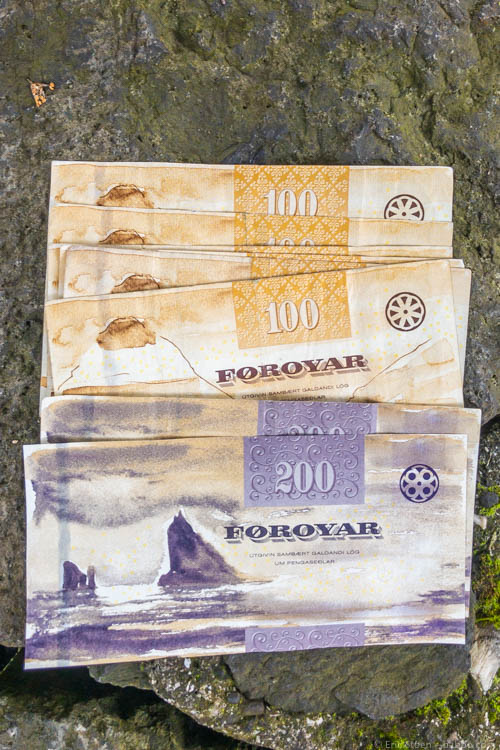
A Faroe Islands Packing List
We overpacked…by a lot. The weather forecast showed rain and 55(f)/13(c) every day. I looked at other Faroe Island Packing Lists and packed for cold and rain. In reality it was cool a few days and nicely warm the rest of the time – as hot as 72(f)/23(c) two days. We only saw rain once, for roughly 20 minutes in Torshavn. It wasn’t even a heavy rain.
If we went back and had similar weather, this is all our packing list would consist of:
- Two pairs pants – one hiking and one jeans
- One pair shorts
- Two long-sleeve shirts
- Two t-shirts
- Underwear and socks
- Hiking shoes
- Flip flops
- Hiking poles
- A fleece
- A warm puffy jacket
- A football (soccer ball) and small hand pump
- A camera with a zoom lens (I wished I had a zoom for puffin photos)
- Water bottles
- Sunscreen
- Toiletries
This is what we took and didn’t use:
- An additional pair of hiking pants
- Hiking boots
- Raincoats
- Waterproof pants
- Umbrellas
- A dry bag
- A towel
- Long underwear
- Hats and gloves
- Swimsuits (we were never tempted to get in the water anywhere)
- A Frisbee (nowhere to really play)
I can imagine that all of that – other than the Frisbee and maybe the swimsuits – would be necessary if you’re visiting in fall, winter or spring, and it actually rains. But we had bizarrely good weather. I regretted not having shorts to hike in, and flip flops for running to breakfast, etc…
Have you been to the Faroe Islands with kids? What other non-standard hikes and sights do you recommend?


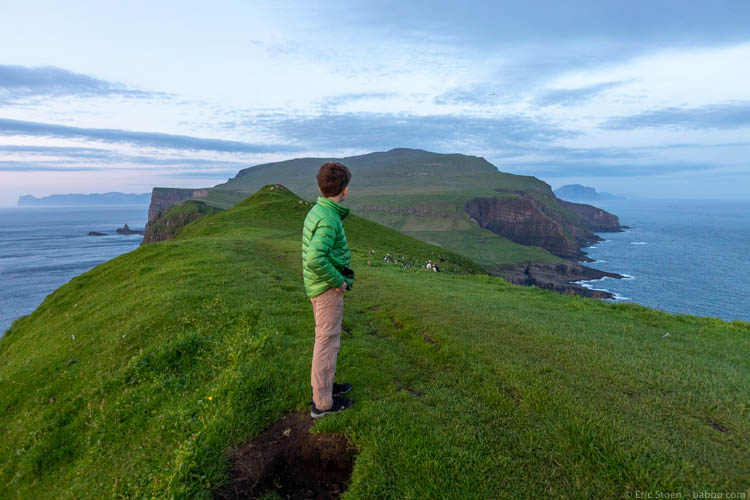
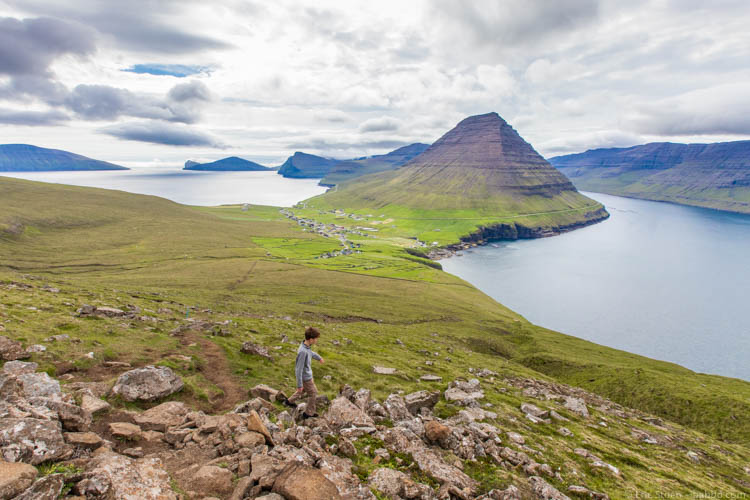
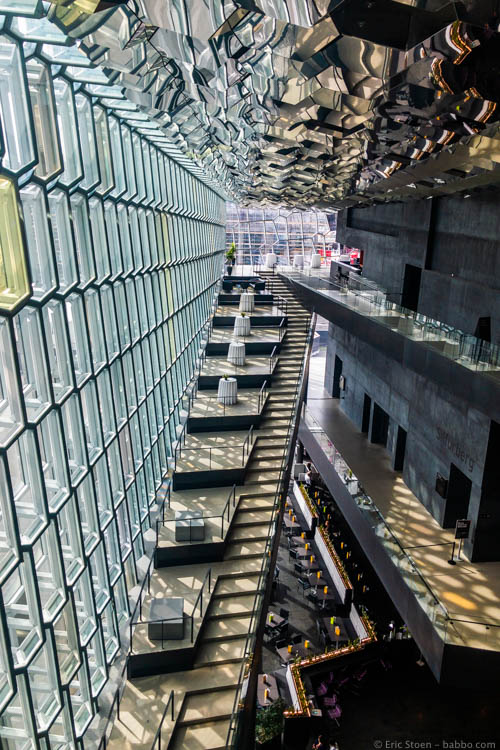
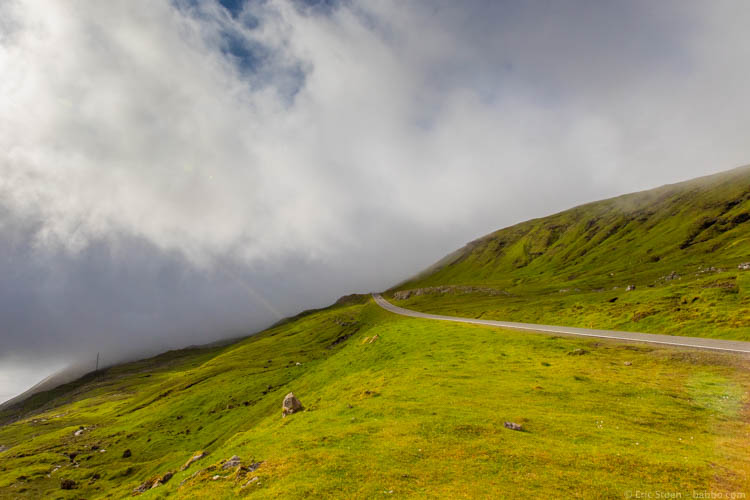
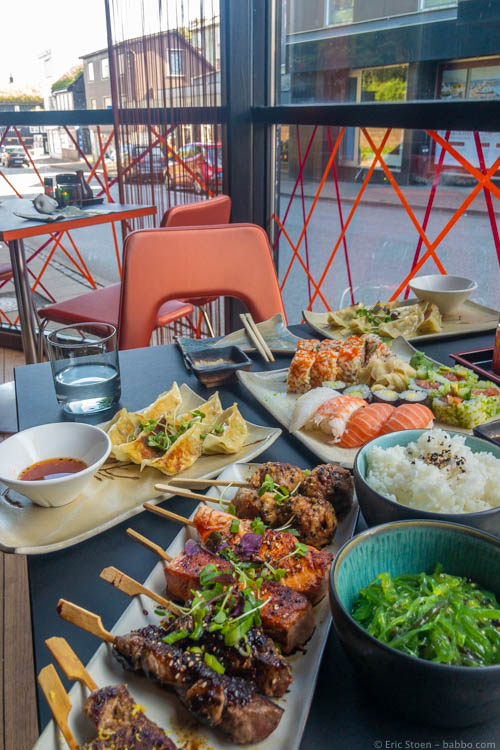
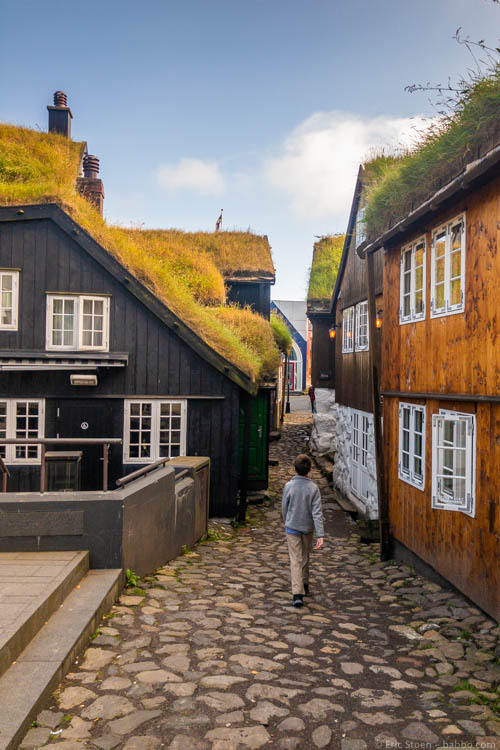
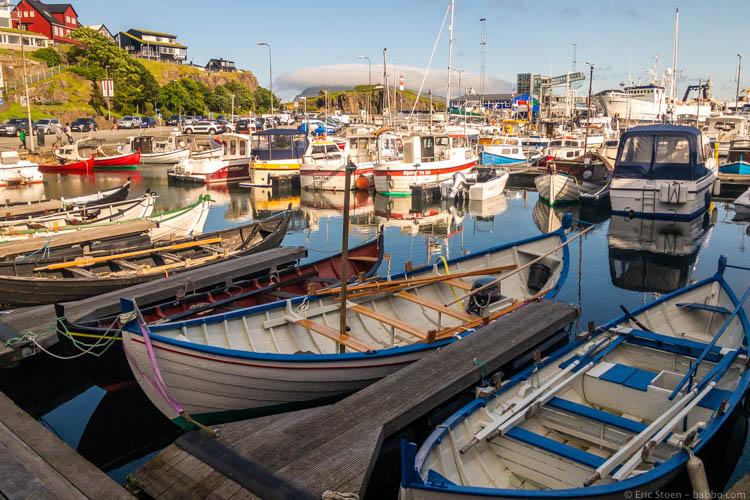
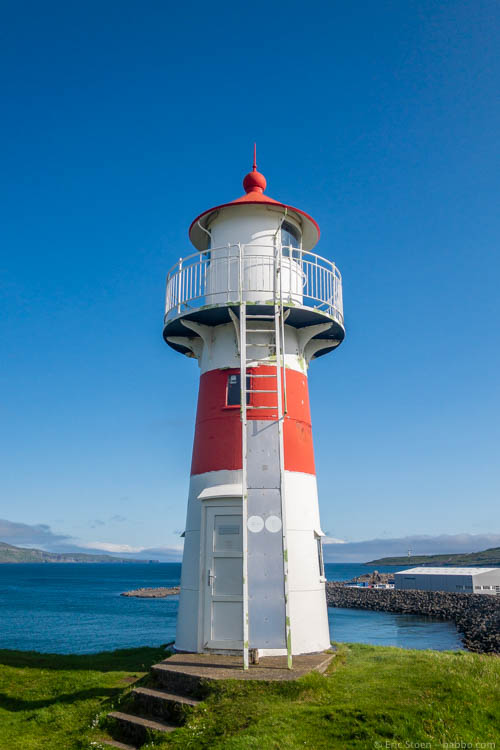
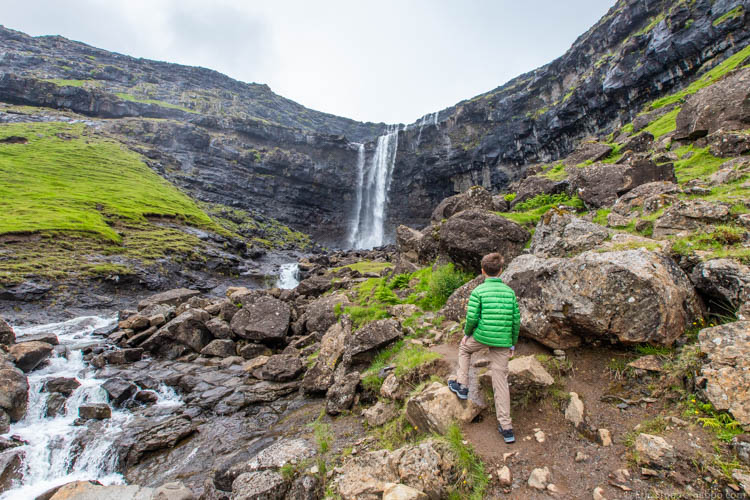
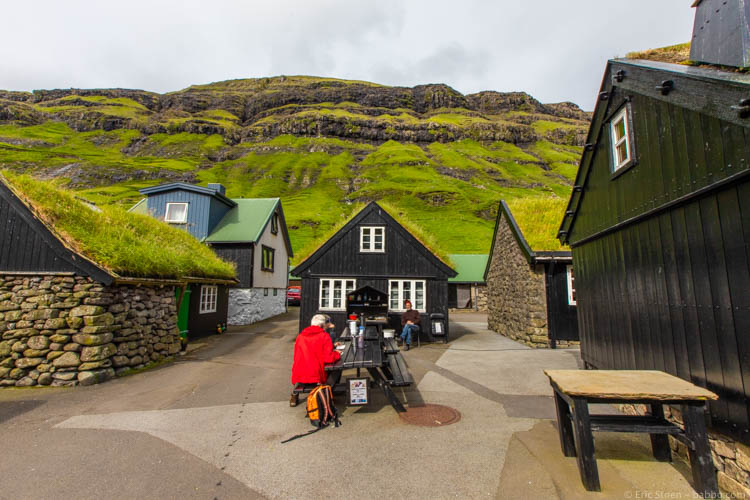
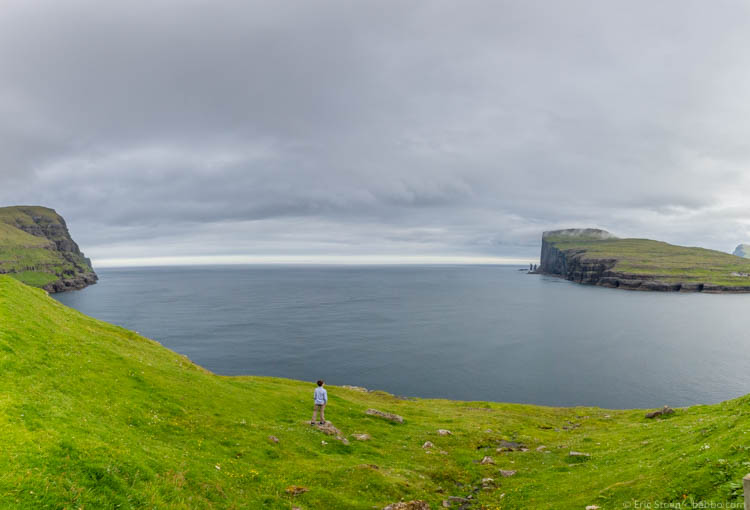
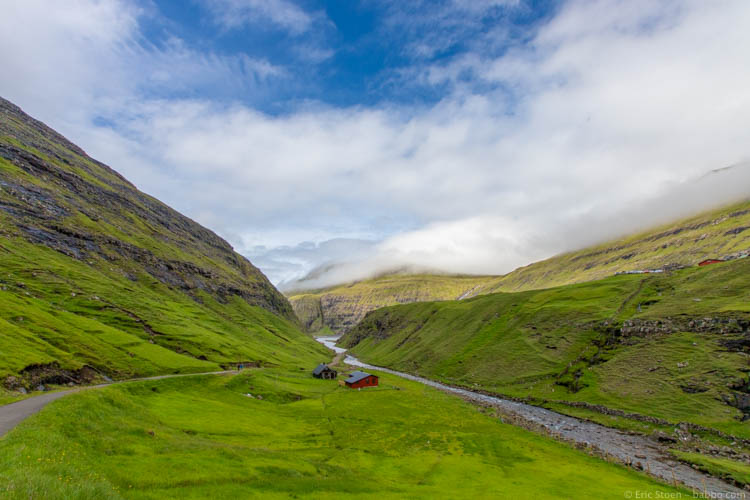
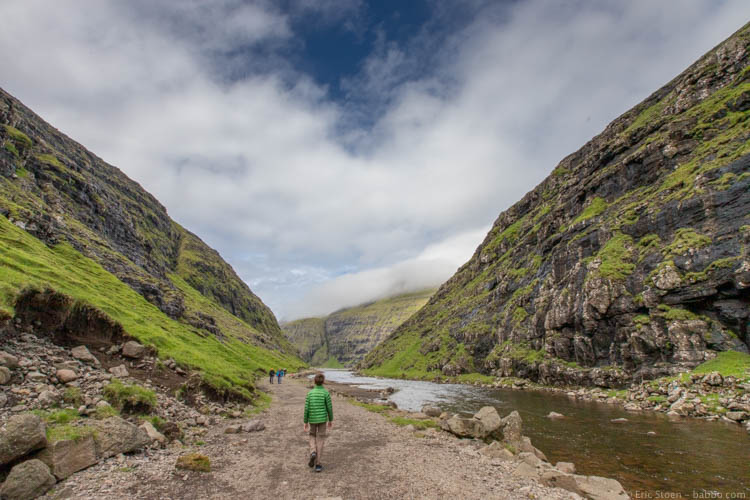
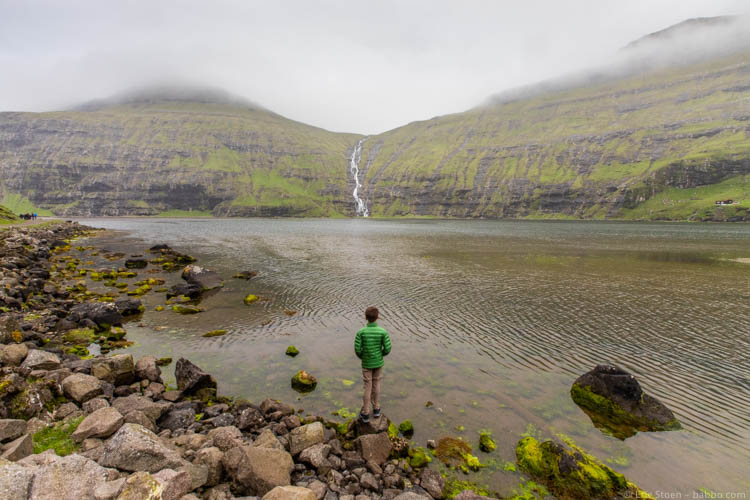

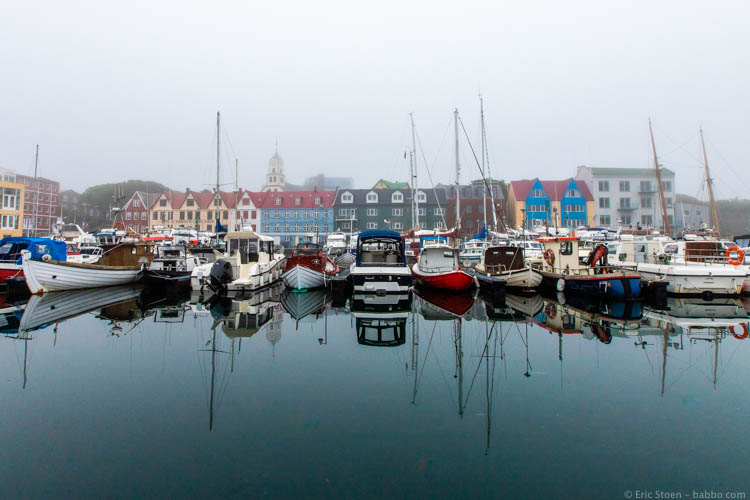
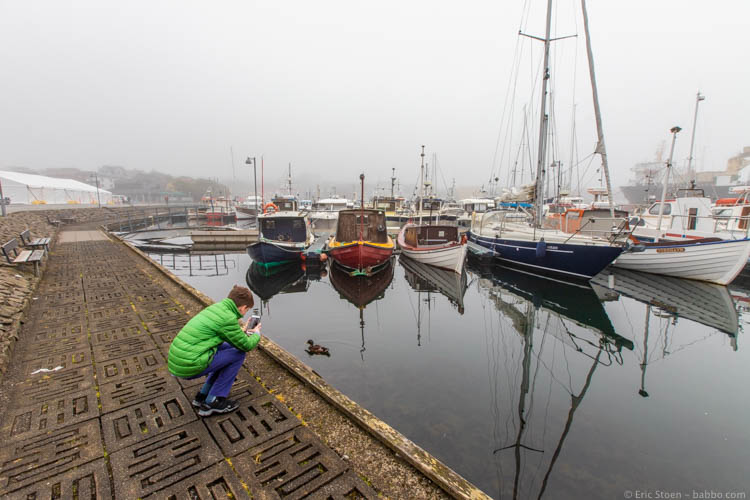
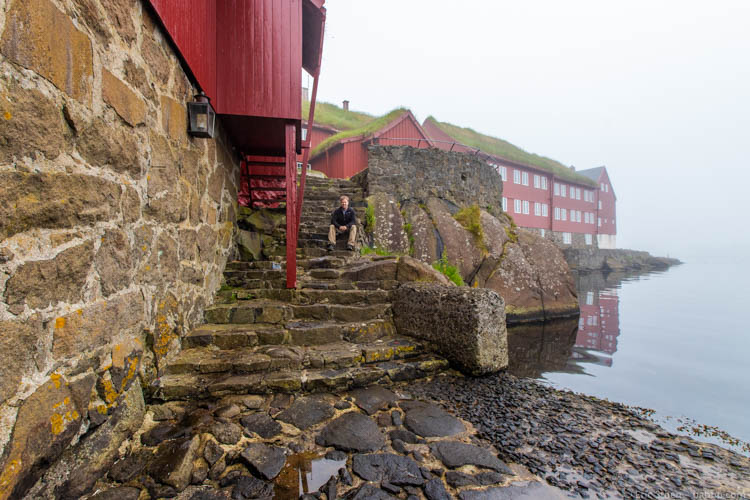
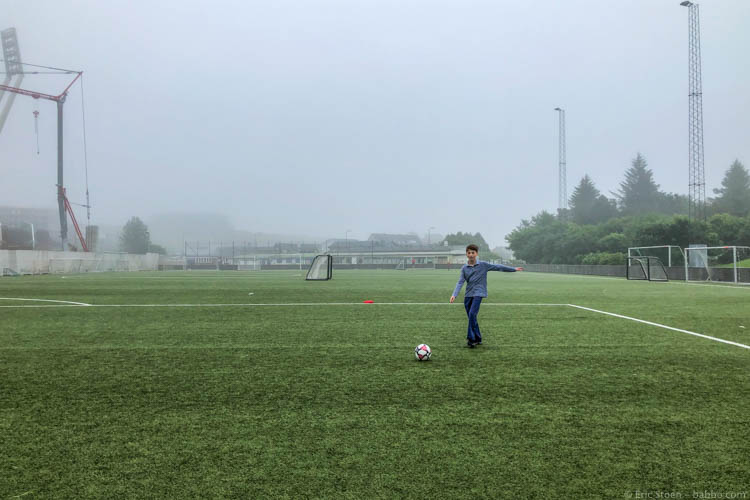
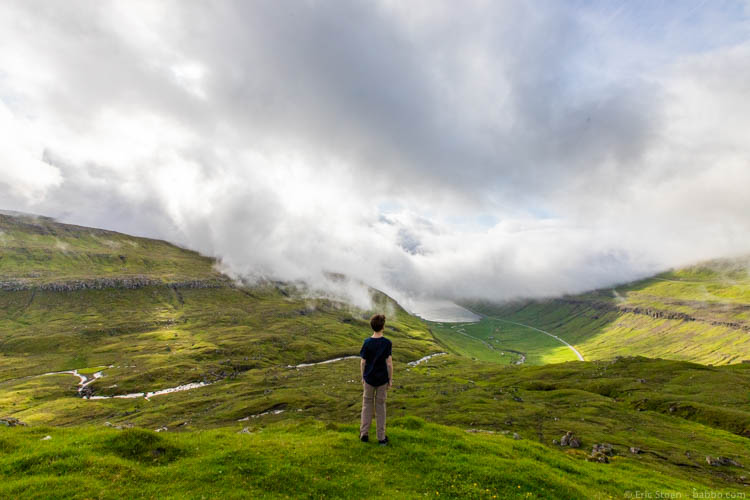
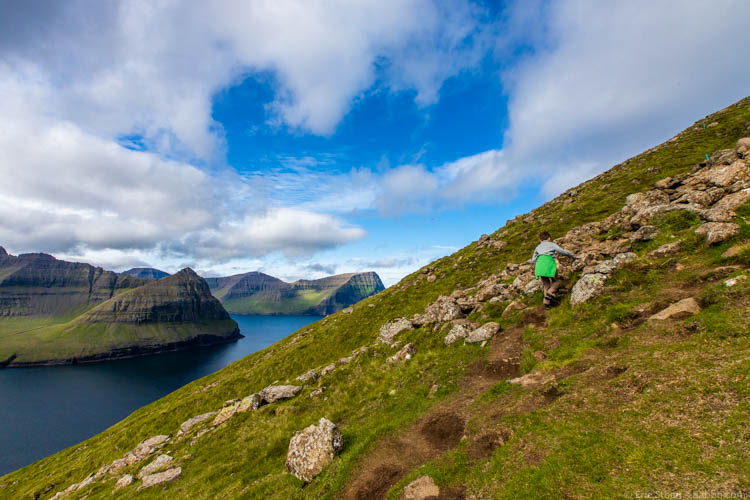
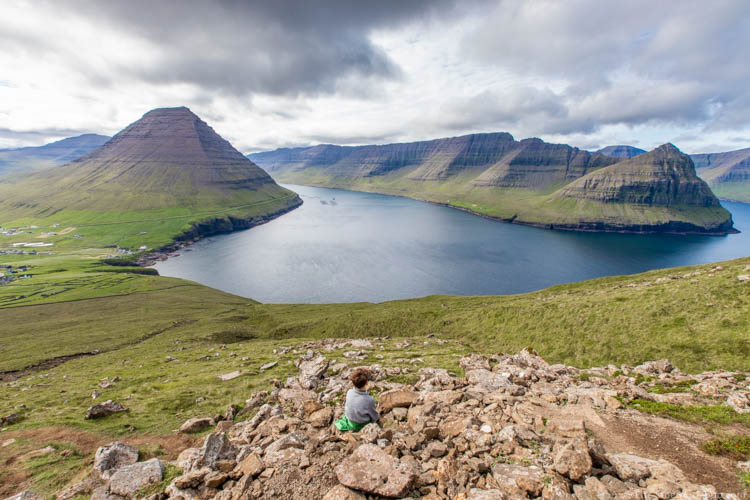

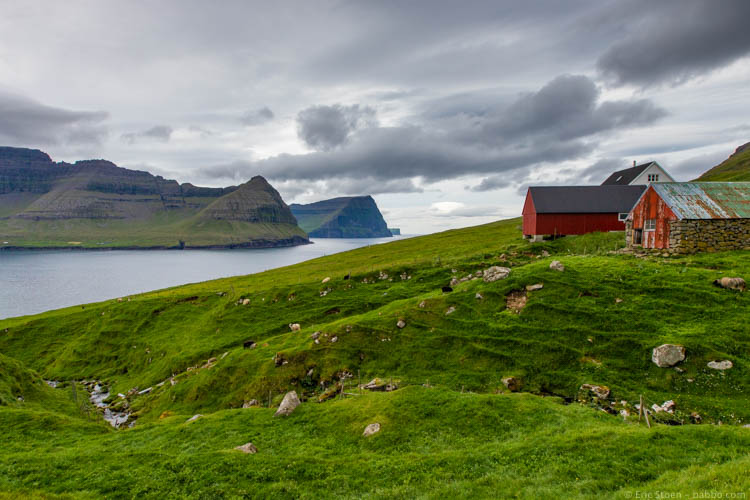
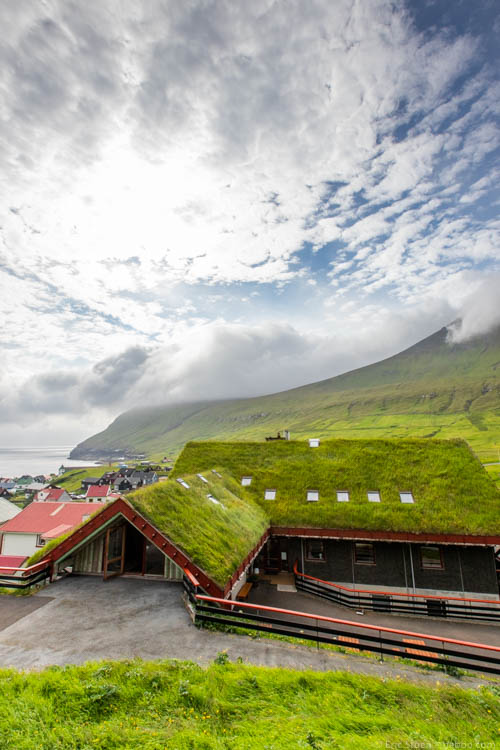
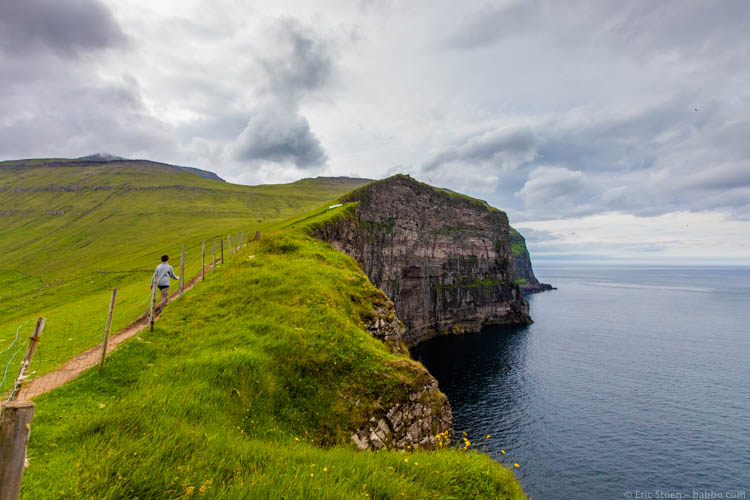
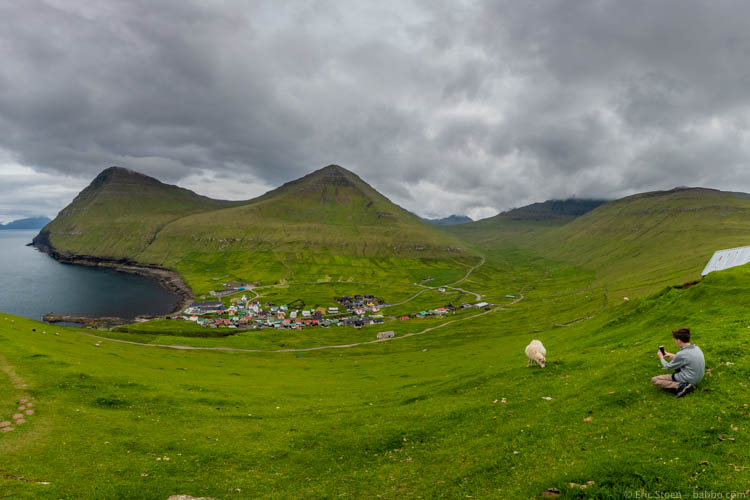
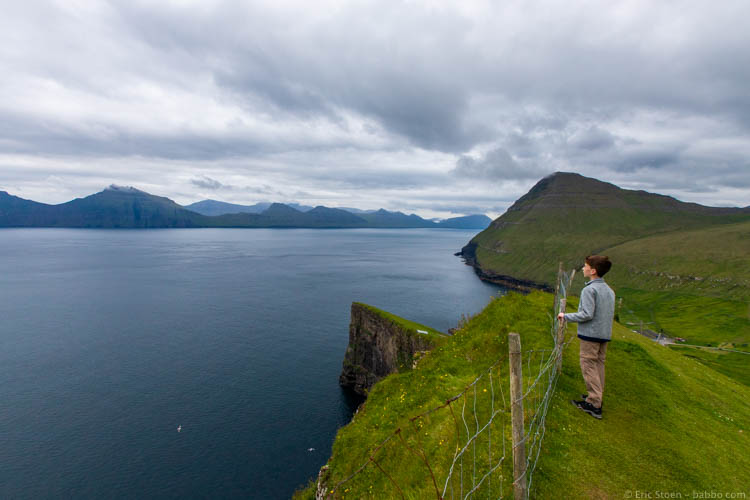
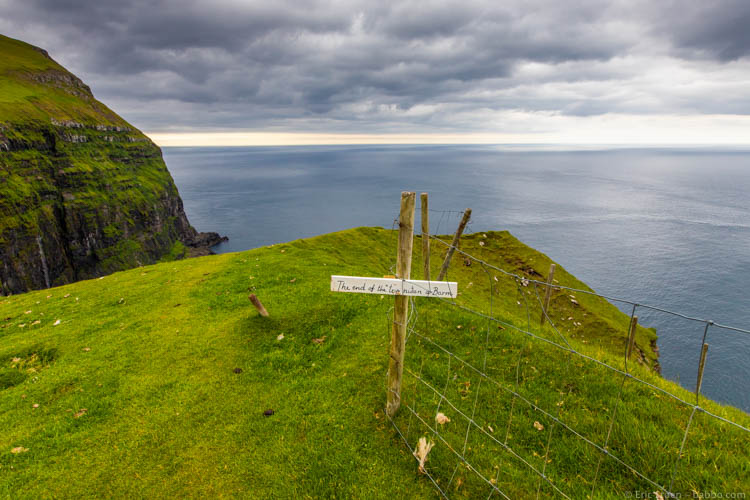
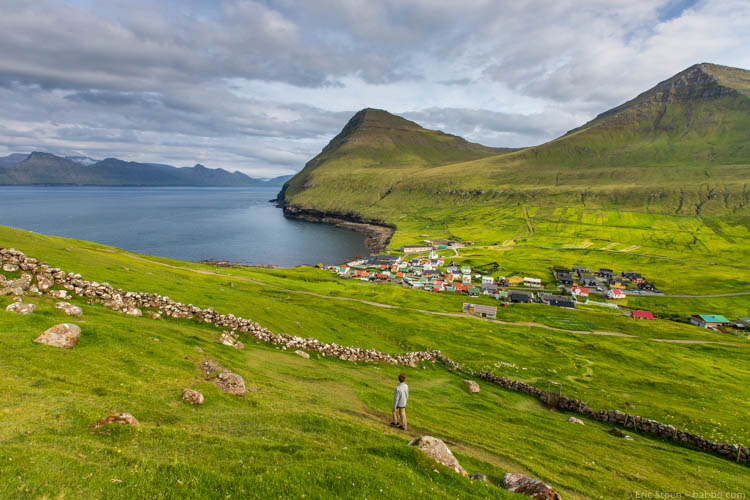
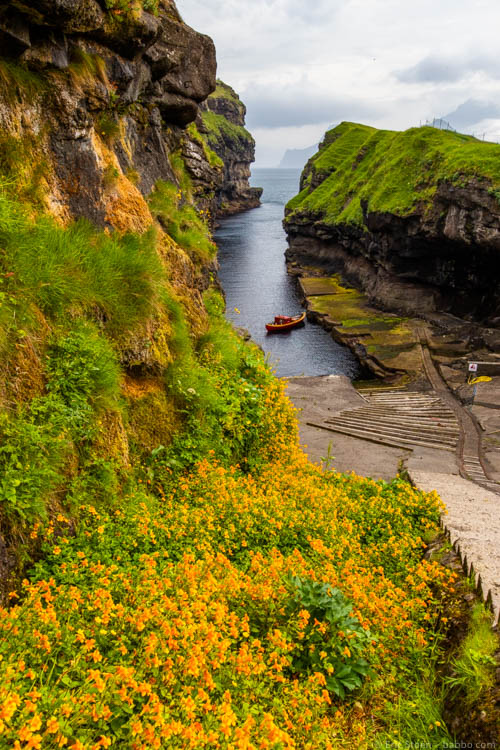
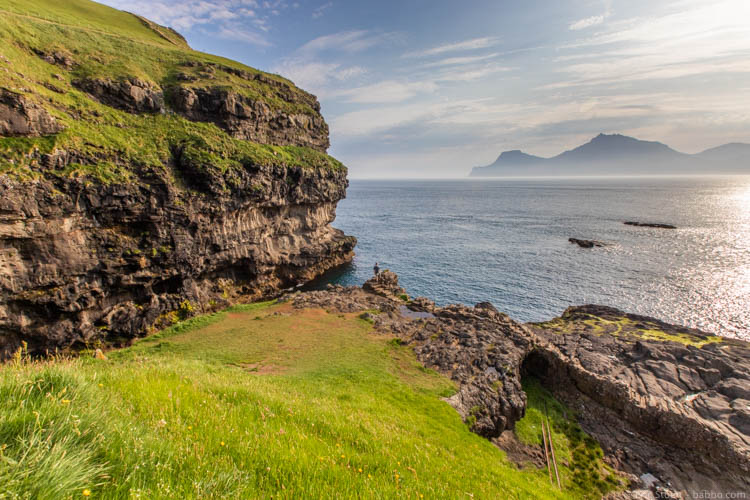
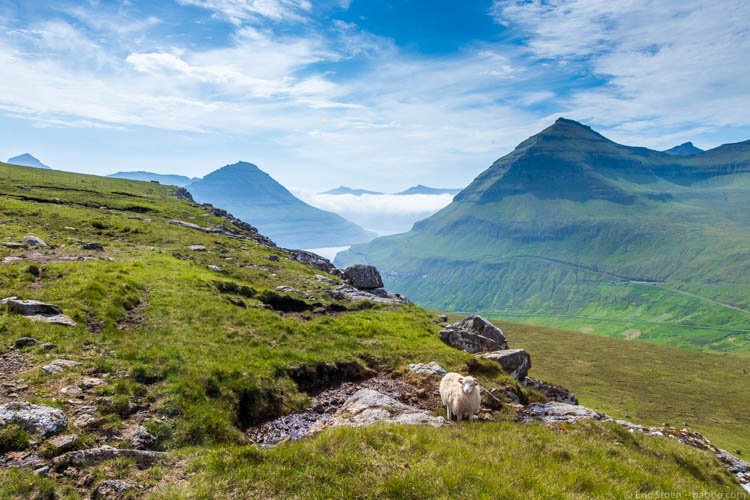
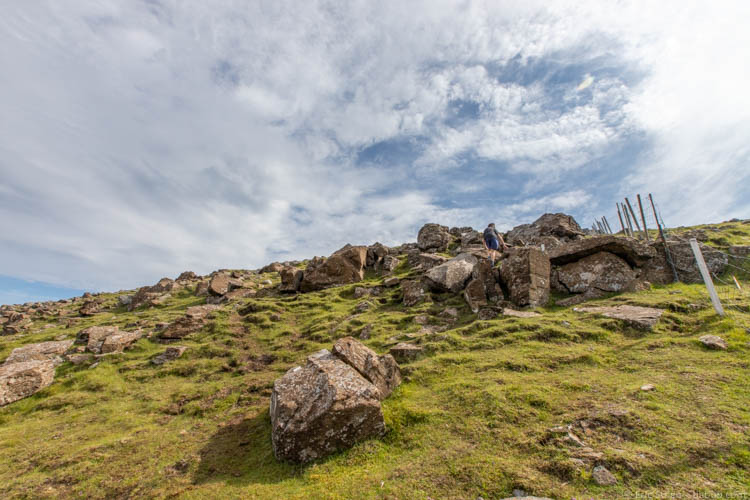
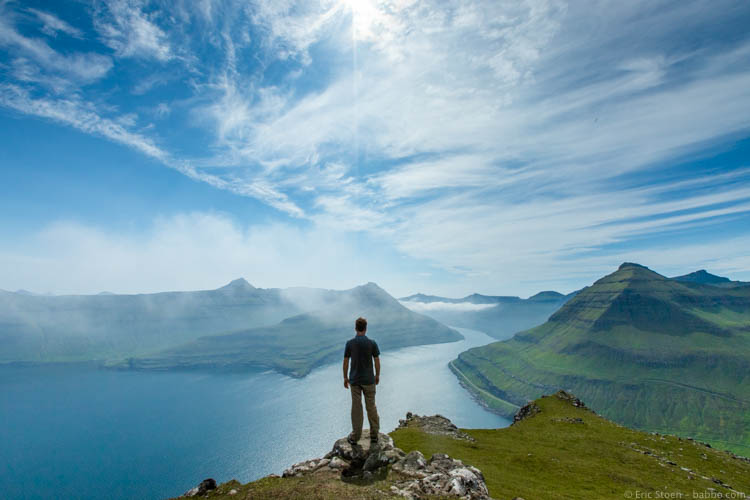
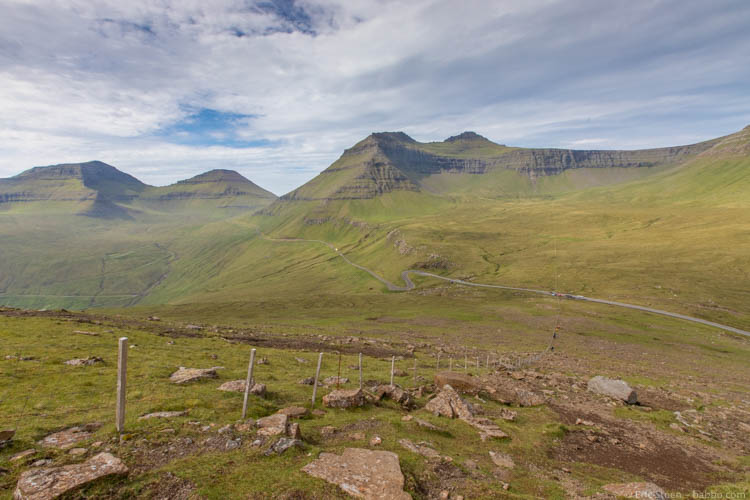
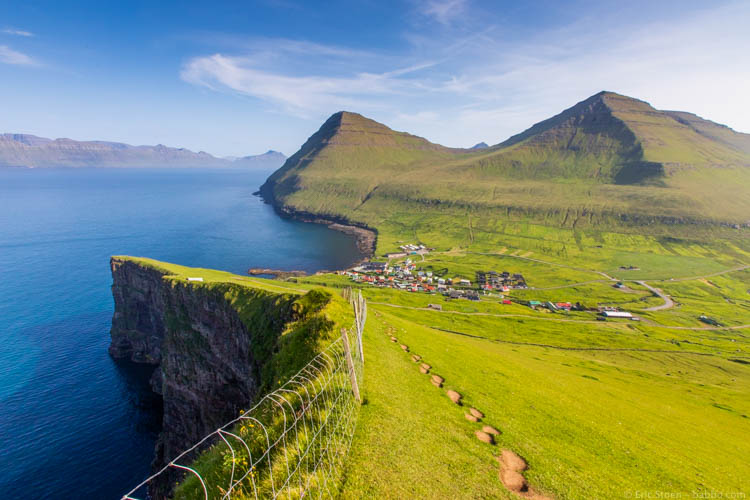
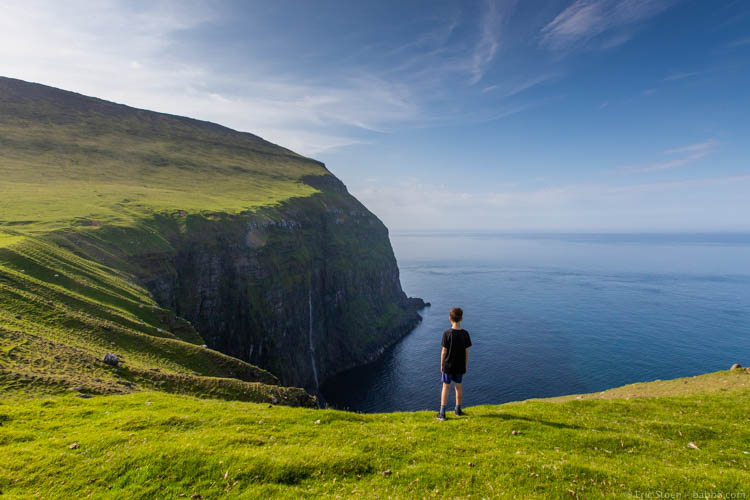
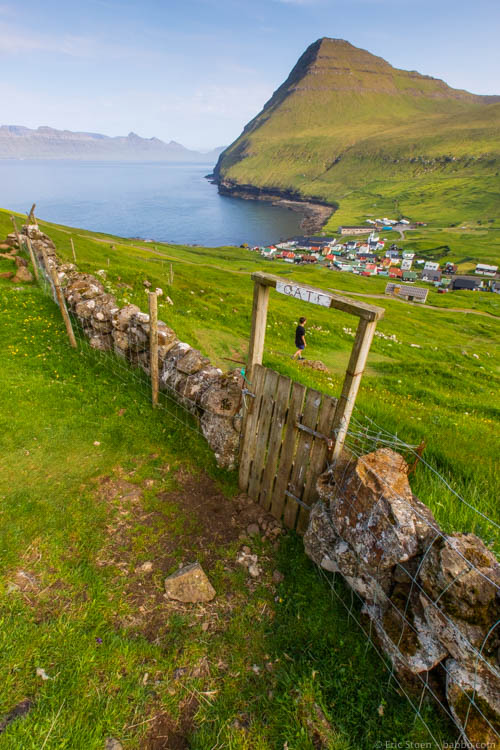
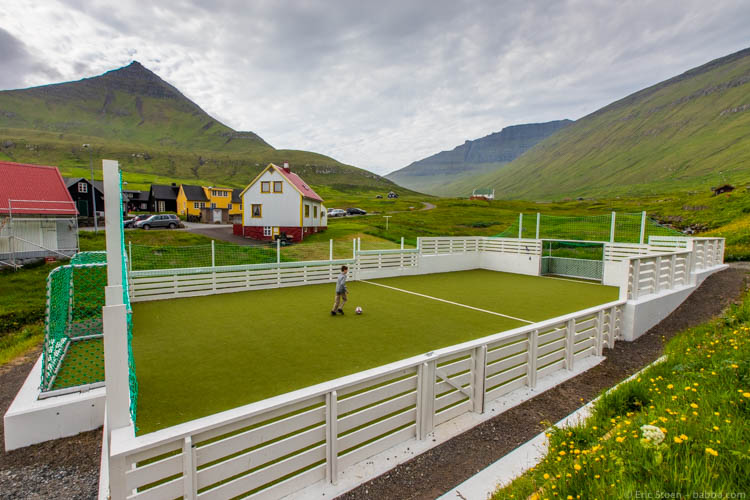
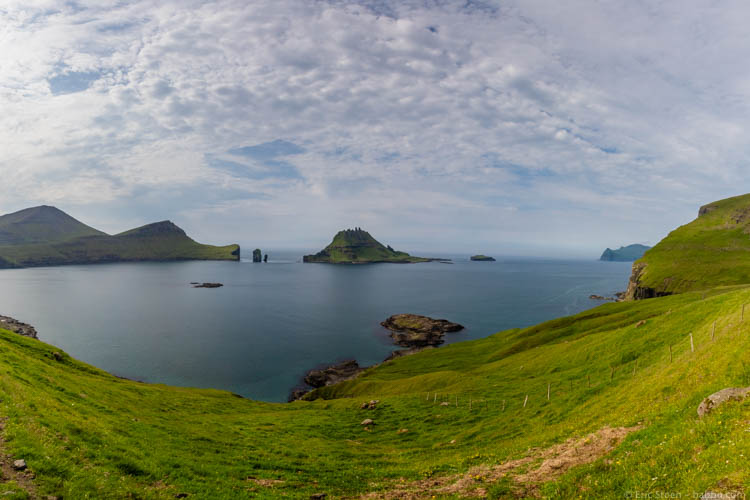
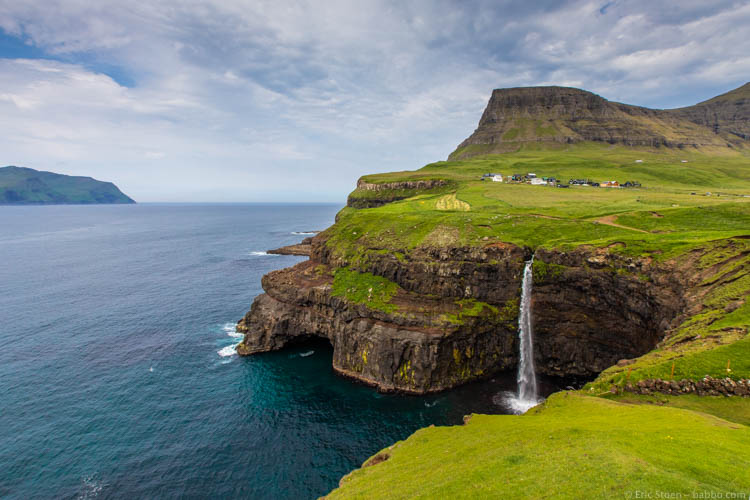
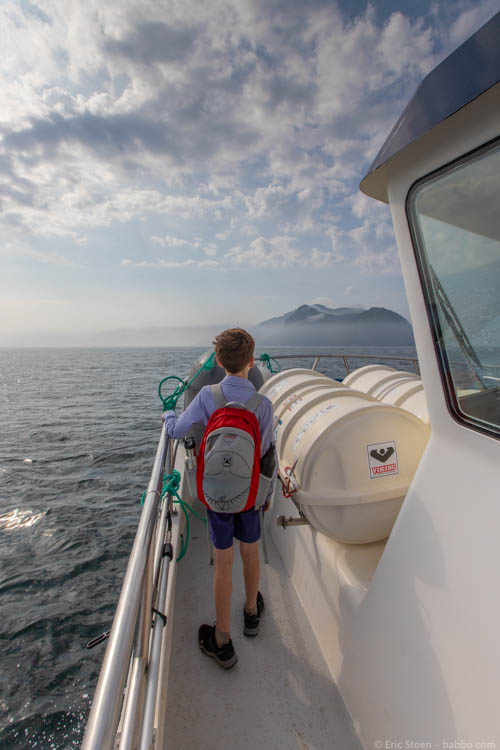
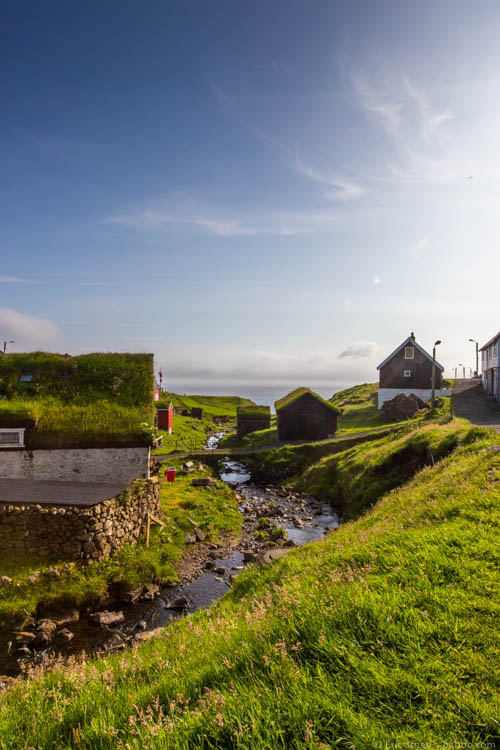
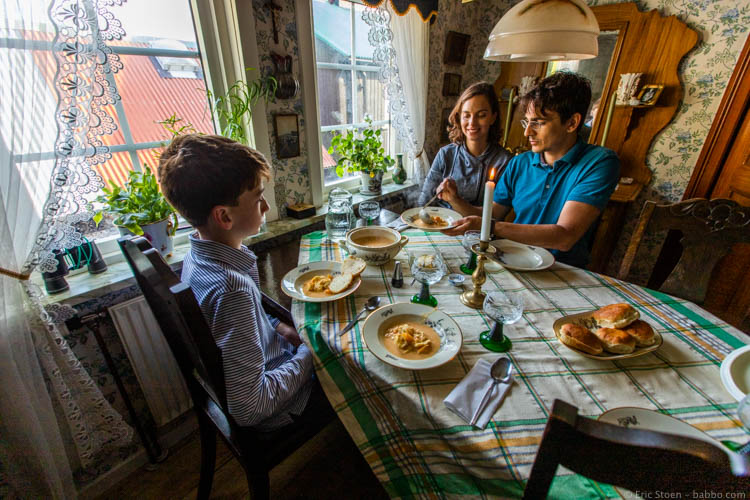
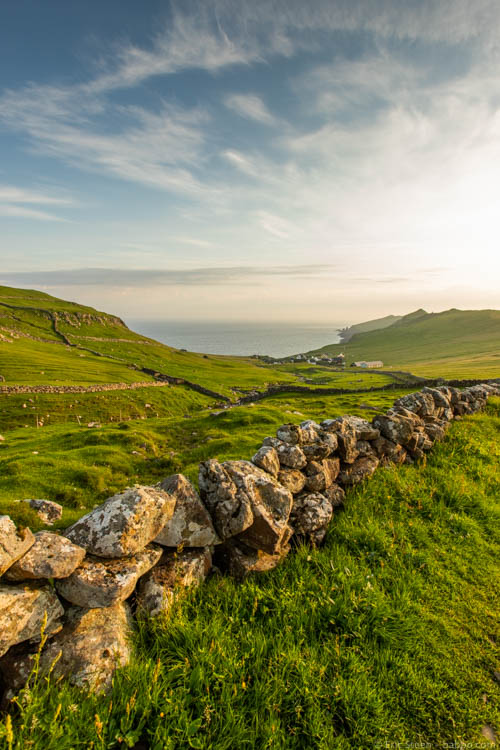
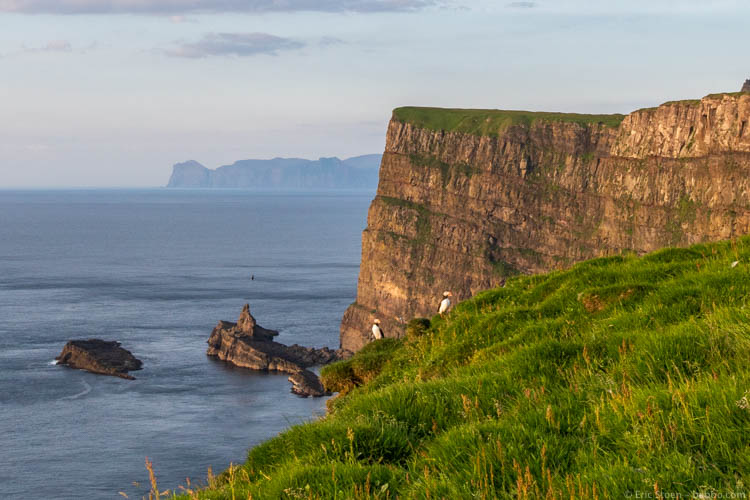
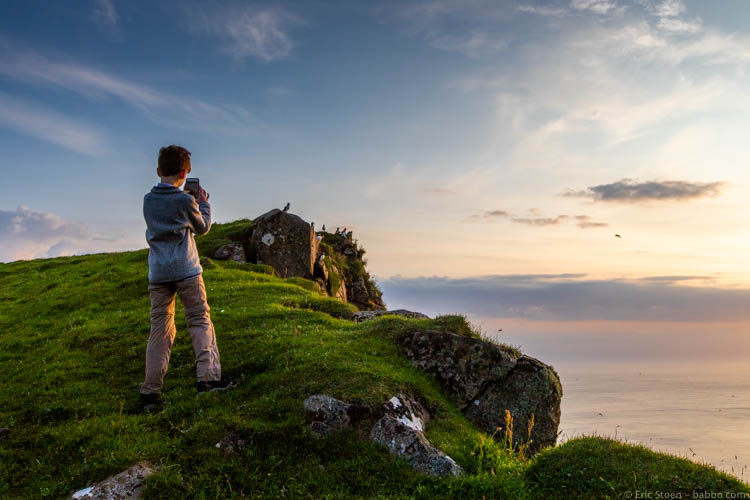
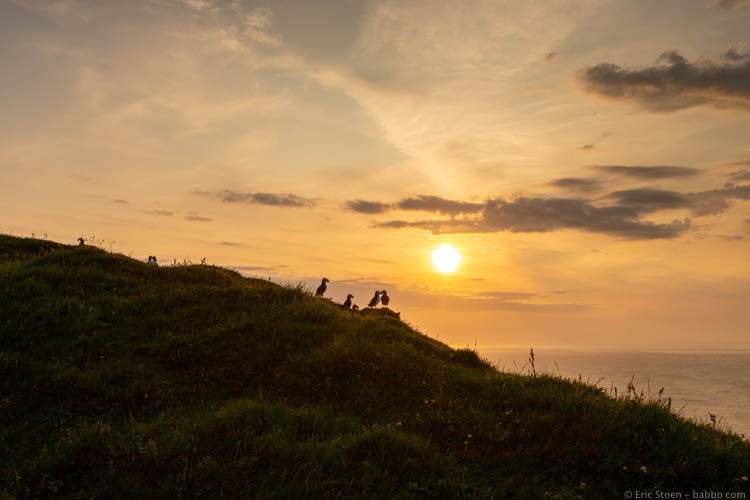
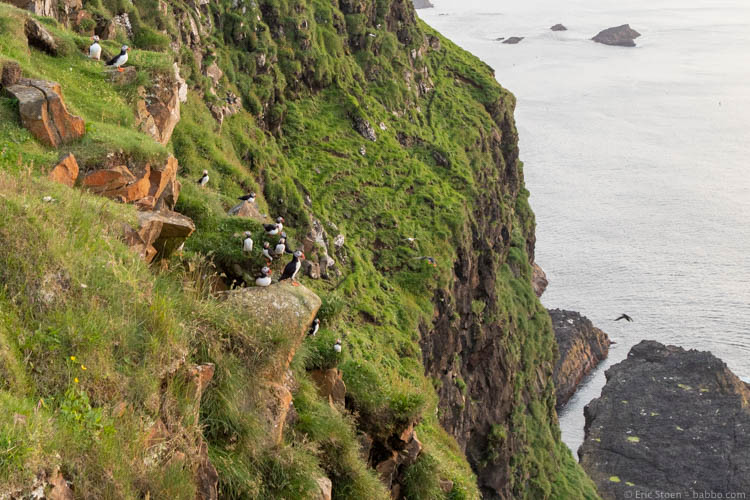
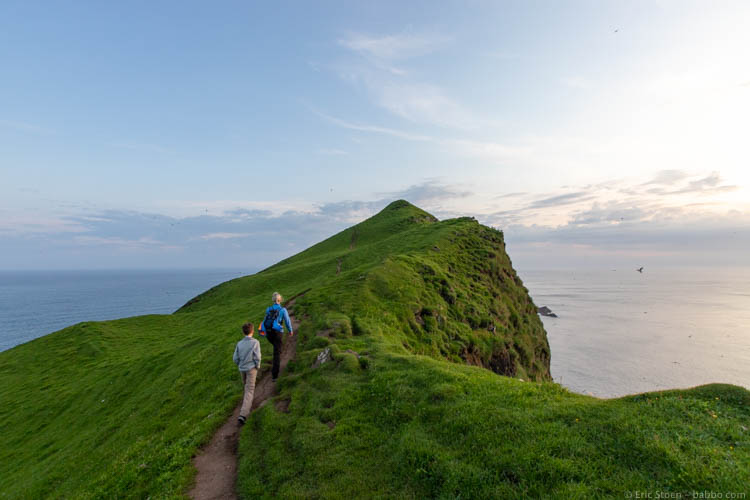
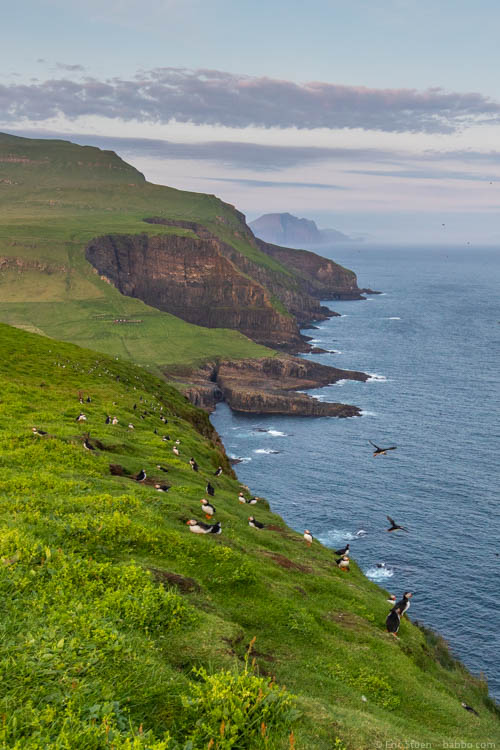
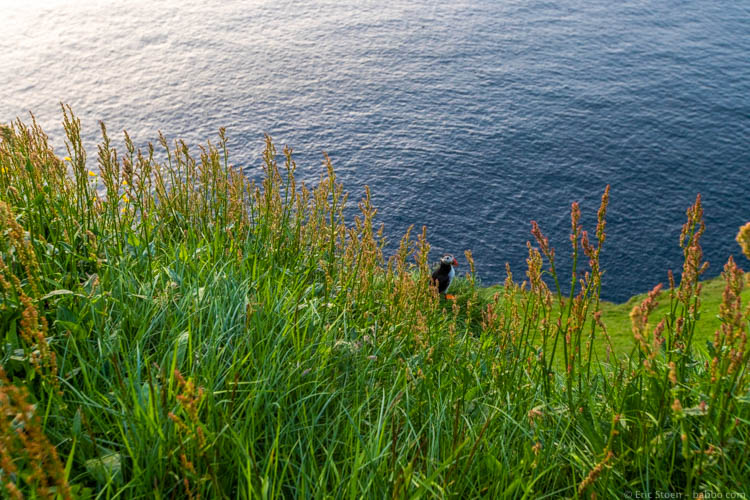
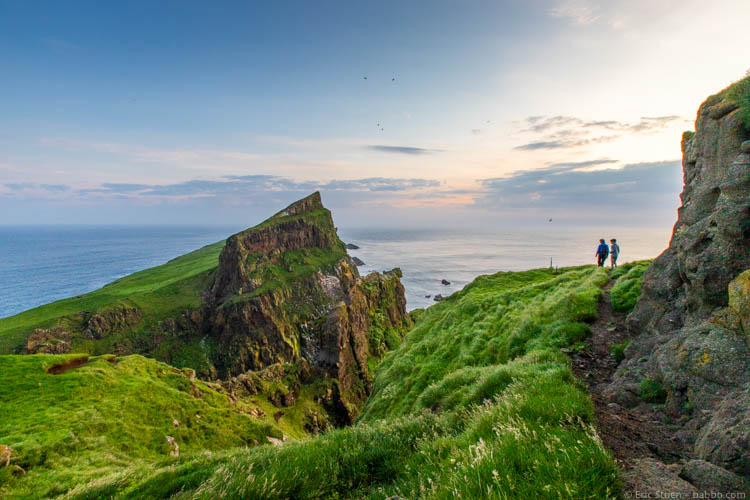
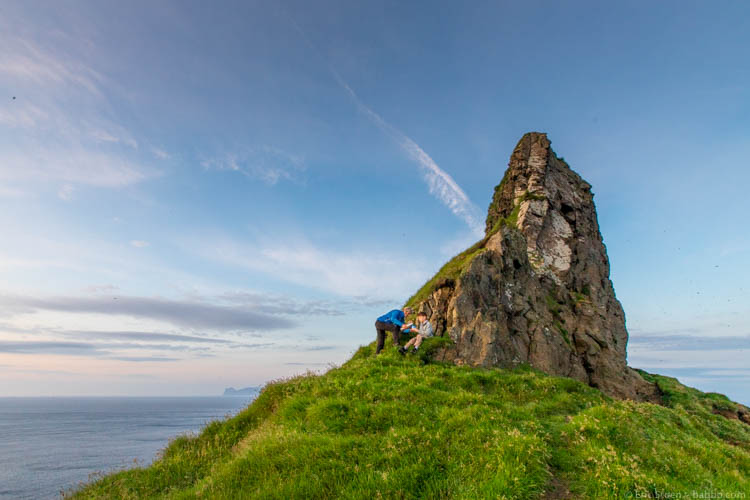

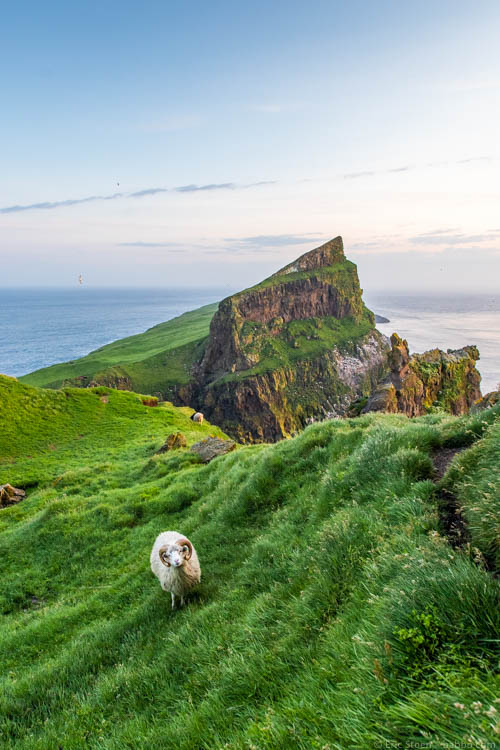
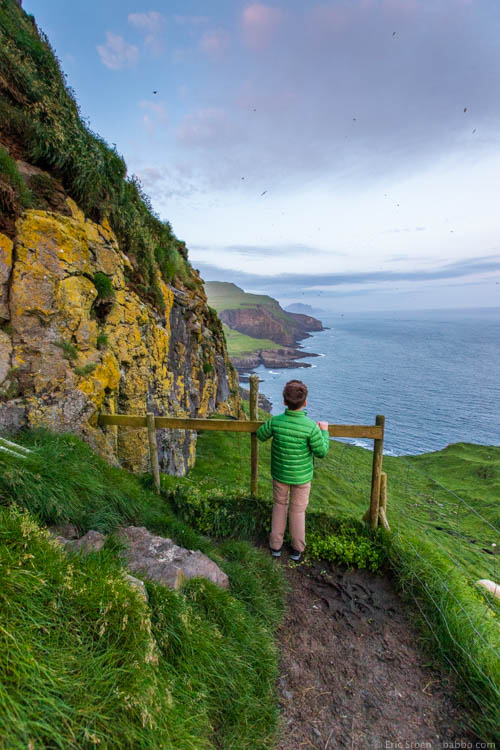
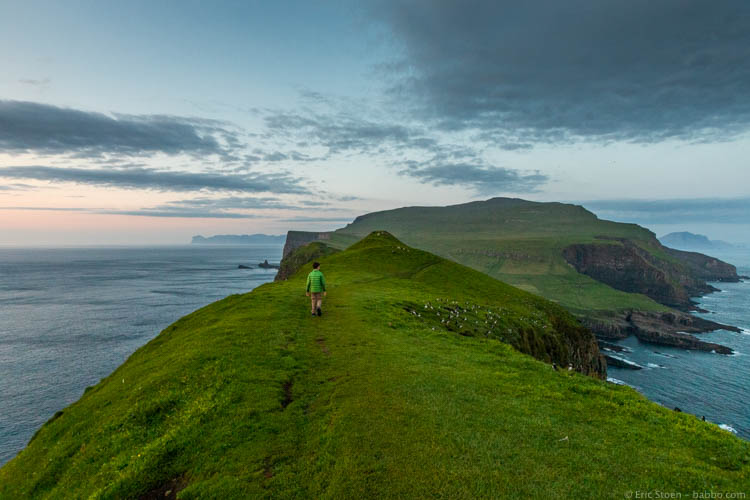
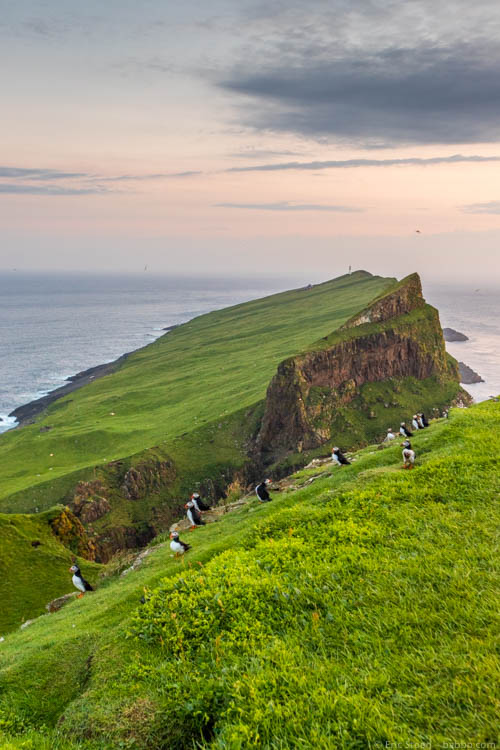
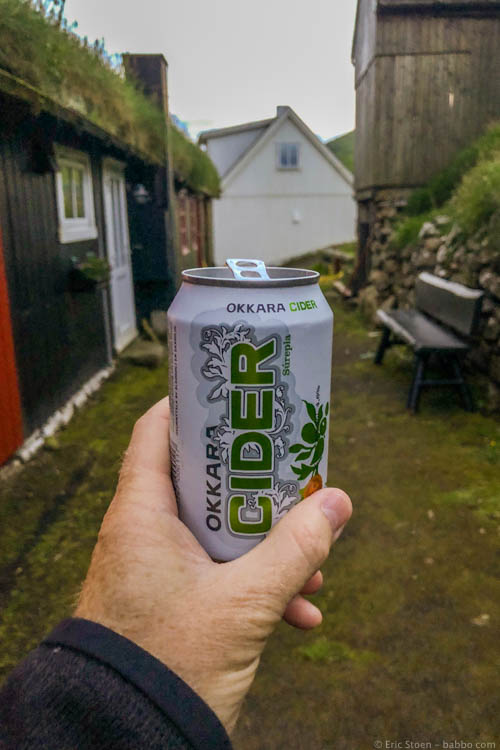
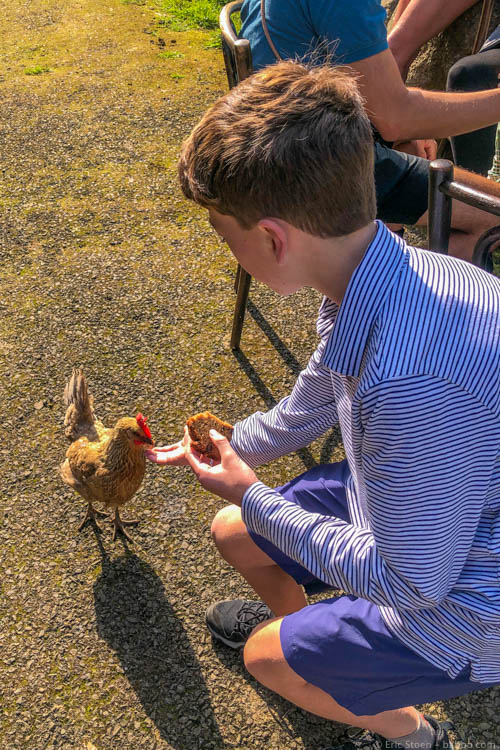
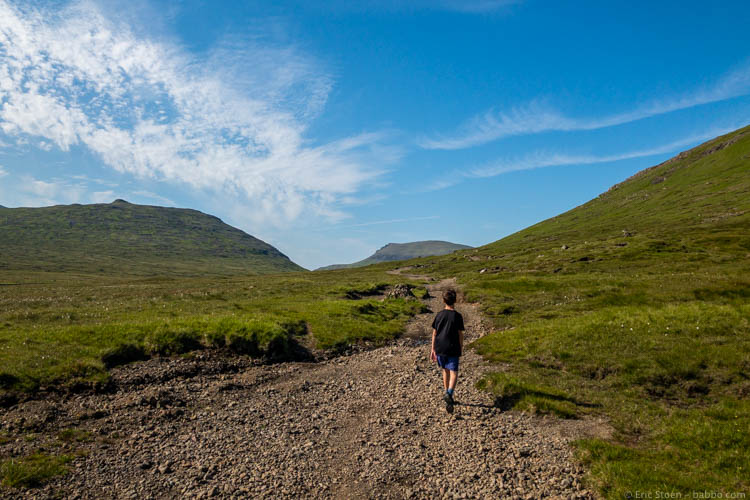
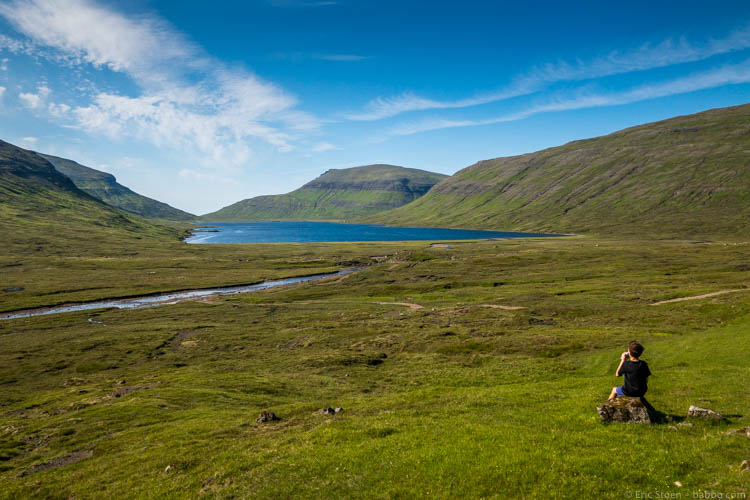
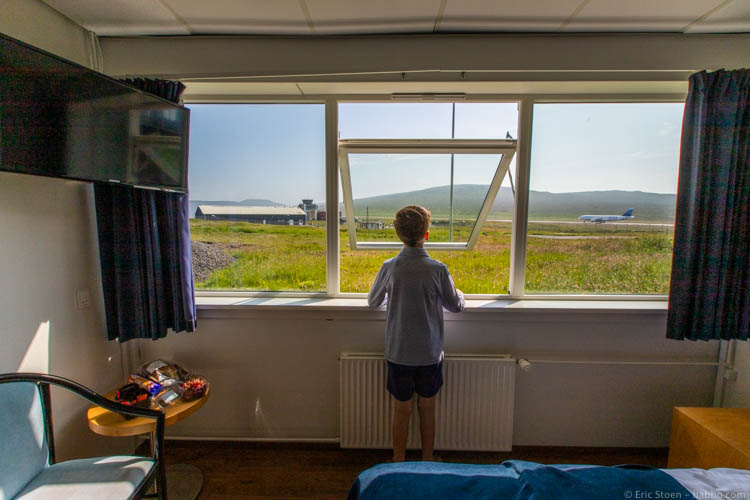

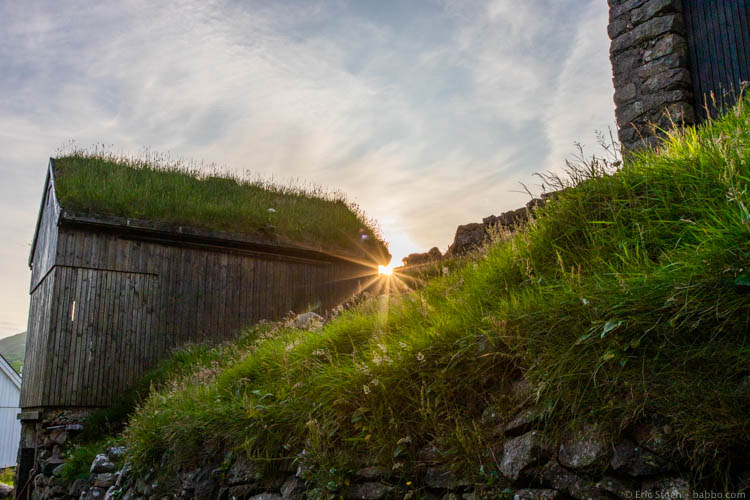
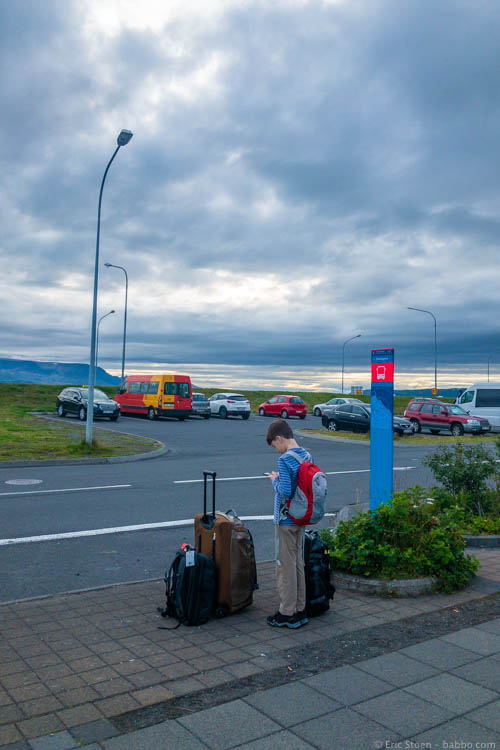
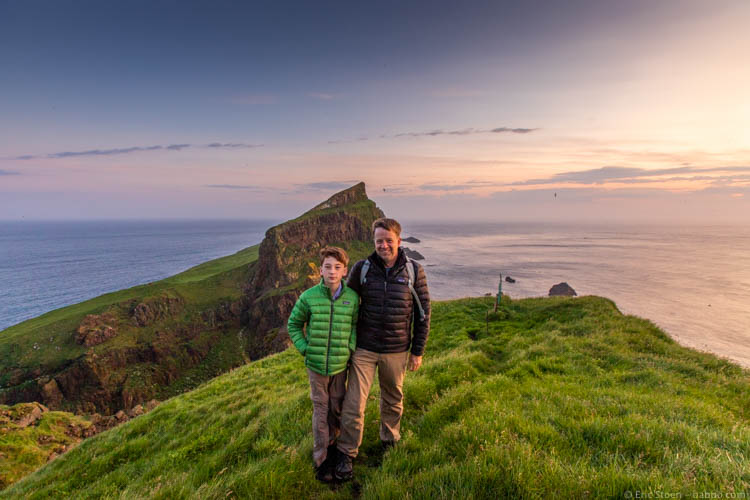
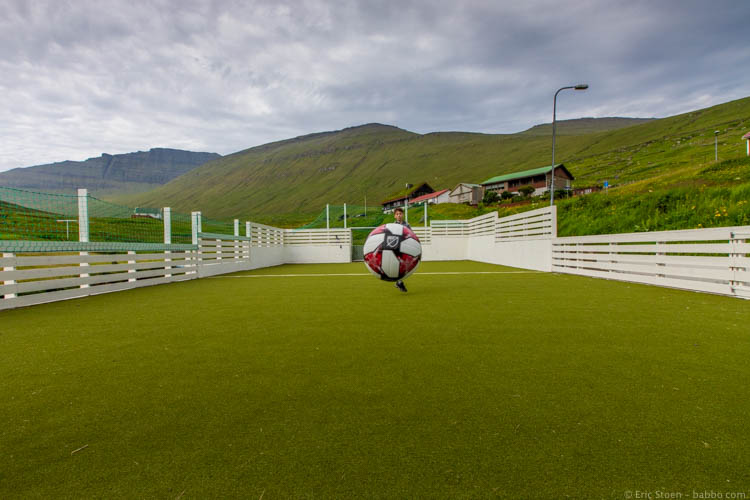
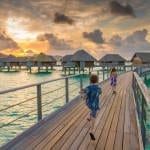

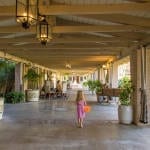

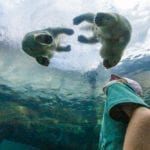

Hi! This is fantastic. Thanks so much. We are planning a trip to Norway in Sept next year (2020) and were hoping to include Iceland but I am now thinking The Faroe Islands would be a much better option. We can leave Iceland for a whole separate trip (although when coming from Melbourne we want to see as much as possible!). ….:)
Absolutely! Both are beautiful, but Faroe Islands are a little more interesting since they’re still largely unknown. Iceland’s become too popular – for good reason, but still, not everyone needs to go all at once!
I am rather new to your blog but I am so impressed with these comprehensive posts! These are so well organized and have just the right amount of itinerary information to make it easier for people like me to gauge how much we can fit into our trip. I am grateful you keep track of all the prices and share them. We have seen a lot of the world with our three kids when we lived in Europe and Asia, so I understand what it takes to make these sort of trips happen. Although yours is different style and budget of travel, I find it very inspiring! Your pictures are absolutely gorgeous too!
Thank you so much for the note Lyana!
Are the dollar amounts you listed in US Dollars or Denmark currency? You did a very amazing job in writing his blog. Made me feel, i am already on the Faroe Island.
Anything marked as DKK is Danish currency. Anything marked as $ is in US Dollars.